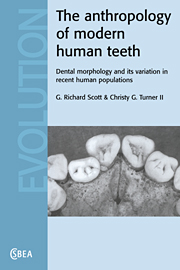 The Anthropology of Modern Human Teeth
The Anthropology of Modern Human Teeth Book contents
- Frontmatter
- Dedication
- Contents
- Acknowledgments
- Prologue
- 1 Dental anthropology and morphology
- 2 Description and classification of permanent crown and root traits
- 3 Biological considerations: ontogeny, asymmetry, sex dimorphism, and intertrait association
- 4 Genetics of morphological trait expression
- 5 Geographic variation in tooth crown and root morphology
- 6 Establishing method and theory for using tooth morphology in reconstructions of late Pleistocene and Holocene human population history
- 7 Tooth morphology and population history
- Epilogue
- Appendixes
- References
- Index
Epilogue
Published online by Cambridge University Press: 05 September 2015
- Frontmatter
- Dedication
- Contents
- Acknowledgments
- Prologue
- 1 Dental anthropology and morphology
- 2 Description and classification of permanent crown and root traits
- 3 Biological considerations: ontogeny, asymmetry, sex dimorphism, and intertrait association
- 4 Genetics of morphological trait expression
- 5 Geographic variation in tooth crown and root morphology
- 6 Establishing method and theory for using tooth morphology in reconstructions of late Pleistocene and Holocene human population history
- 7 Tooth morphology and population history
- Epilogue
- Appendixes
- References
- Index
Summary
We have focused on the description, classification, genetics, and variation of crown and root traits of the permanent dentition in recent and modern human populations. This emphasis was dictated first, by our own interests and second, by the available literature. Dental morphologists have concentrated traditionally on just those issues presented here. Other promising avenues of research in dental morphology were barely touched upon, if at all. The intent of this epilogue is to review briefly areas where the potential of tooth morphology has been partially but not fully exploited.
The morphology of deciduous teeth
For reasons noted in chapter 1, dental anthropologists have concentrated on permanent teeth to the near exclusion of deciduous teeth. This seems to indicate general agreement with Lasker's (1957:415) remark that ‘A systematic analysis of racial traits of the deciduous dentition does not seem warranted... in general the characteristics are similar to those of the permanent dentition.’ Many crown traits expressed in the primary dentition foreshadow the expression of the ‘same trait’ in the permanent dentition. Populations with high trait frequencies on deciduous teeth typically have high, albeit reduced, frequencies on the permanent teeth. It is not infrequent, however, to find dentitions where traits expressed on the primary second molars are not expressed on the permanent molars. An individual may exhibit, for example, a well-developed protostylid on dm2 and no manifestation of this trait on LM1, LM2, or LM3. If only permanent teeth are observed, such an individual would be scored as absent or unaffected for the protostylid, even though they seemingly have the genes for trait expression. What are the ramifications of this inconsistency? The assumption is that genes regulating trait development on deciduous teeth are the same genes acting on permanent teeth. A thorough study of the genetics of deciduous crown morphology is needed to resolve this problem, but such an effort would require a long-term project. Dental casts would have to be obtained from children and then, 15-25 years later, from their children.
It has often been observed that deciduous teeth are more primitive, or evolutionarily conservative, than permanent teeth. Brabant (1967:897) states The working hypothesis here is that, as the permanent dentition succeeds the deciduous teeth, the pathologic characteristics of the permanent teeth must be more frequent, and evolution must be more rapid than in the deciduous dentition.’
- Type
- Chapter
- Information
- The Anthropology of Modern Human TeethDental Morphology and its Variation in Recent Human Populations, pp. 308 - 317Publisher: Cambridge University PressPrint publication year: 1997


